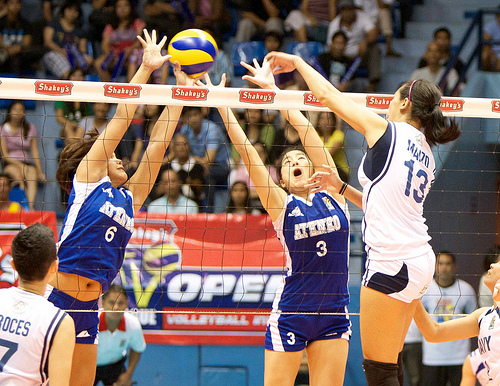- You are here:
- Home »
- Blog »
- Volleyball »
- How to Increase Your Vertical Jump for Volleyball
How to Increase Your Vertical Jump for Volleyball

Photo By: Jomar Galvez
Are you wondering how to increase your vertical jump for volleyball? Being able to jump higher can be a major benefit in helping you to improve your game. There are obvious benefits for attackers and blockers.
Jumping higher isn’t the only benefit to this type of training. Being more explosive and powerful can make a positive impact in all aspects of the game. Volleyball is a speed and power based sport, so the more powerful the better.
Lower Body Strength
If you never lifted seriously before, you may not like it or see how it can help your game, but a good level of lower body strength is very important if you are hoping to jump high. The vertical jump ultimately comes down to how much force you can generate against the ground quickly. You can’t generate any force quickly if you can’t develop force at all.
Beginners should focus on compound exercises, such as back squats, front squats, and deadlifts. These are proven exercises for strengthening the lower body and lower back, which are both crucial for power development. Supplementary exercises such as lunges, step-ups, and different hamstring curl variations are great for strengthening the legs.
Olympic lifts, such as the clean, snatch, and all their variations, are great overall power and strength developers. These can be trickier for beginners, but they can provide many benefits if you learn to do them right.
Plyometrics
Plyometrics are explosive exercise that are used to build power. Most jumping drills and exercises can be considered plyometrics. Why do we do them? In general, the more similar an exercise is to the goal exercise, the more likely it is to help that exercise. So basically, jumping explosively will help you jump explosively better. They have also been proven in many studies, including this one, to lead to positive improvements in anaerobic power output and vertical jump performance.
Depth jumps are one great plyo exercise. You simply step off of a short box or bench and immediately jump for height after hitting the ground. These are very demanding on the body and you should start with a conservative height to step off from. You can see a demo in the video below.
Box jumps are another great jumping exercise. As you could probably guess from the name, you simply jump onto a box. Again, go with a conservative height to start, unless you want to see busted-up shins. The video below shows a demonstration of box jumps.
Why do we work on lower body strength before plyometrics if they are so effective? Most strength coaches recommend having a certain level of strength before doing jump training. This is because they are very intense and can cause a lot of damage to the body if you aren’t strong enough to withstand it. Many experts recommend having experience and base strength with exercises like the barbell squat before getting into jumping drills. Females especially are at an increased risk of knee injuries. This could be caused in part by a lack of strength and muscular development.
It’s easy to see the benefits of plyos and they can make a great addition to many experienced volleyball training programs. Just be cautious when introducing them to a new athlete. They may seem like harmless jumping, but if they are done right, they are very challenging to the body. Always warm up and use proper technique. Be conservative when planning the heights for each jump until the athlete proves capable.
Plyometrics should be done with a limited number of reps. Remember, they are done for power development, not endurance training. Many coaches make the mistake of having their athletes perform too many jumps. Combined with the number of jumps performed in a practice, they might get more endurance work than power training, which could actually hurt their max vertical jump. Keep the reps limited and as explosive as possible to recruit the maximum number of muscle fibers. They should also be done at the start of a training session, only after a warm-up, to ensure the athlete is fresh.
Upper Body Strength
Why do you need to train the upper body to jump higher? While it may be less important than the lower body, it is still involved in jumping. Jumping is really a total body exercise, because force transfers through the entire body and is exerted upwards. If you are weak in the upper body, particularly the back, you won’t be able to transfer force upwards. Having a strong back can also help lead to proper posture when the athlete is fatigued. If you have poor posture, your jumping technique won’t be very good. Exercise such as the bench press and lat pulldowns can help upper body strength development.
Core Strength
Similar to the upper body part listed above, the core helps transfer power and stabilize the body during a jump. It is much harder to jump high if your shoulders are hunched forward because you have a weak back for example. You’ll want to work the core in all directions, because in a match you’ll be jumping from different directions and angles. Planks, side bends, and kettlebell swings are great for the core. These combine to hit the core from all directions, including the abs, obliques, and lower back. A strong core will help to stabilize your posture on the court.
Improving your vertical jump for volleyball can have a great impact on all aspects of your game. Power and jumping ability are crucial in volleyball. While it may take awhile to see increases, they will be well worth the wait.

